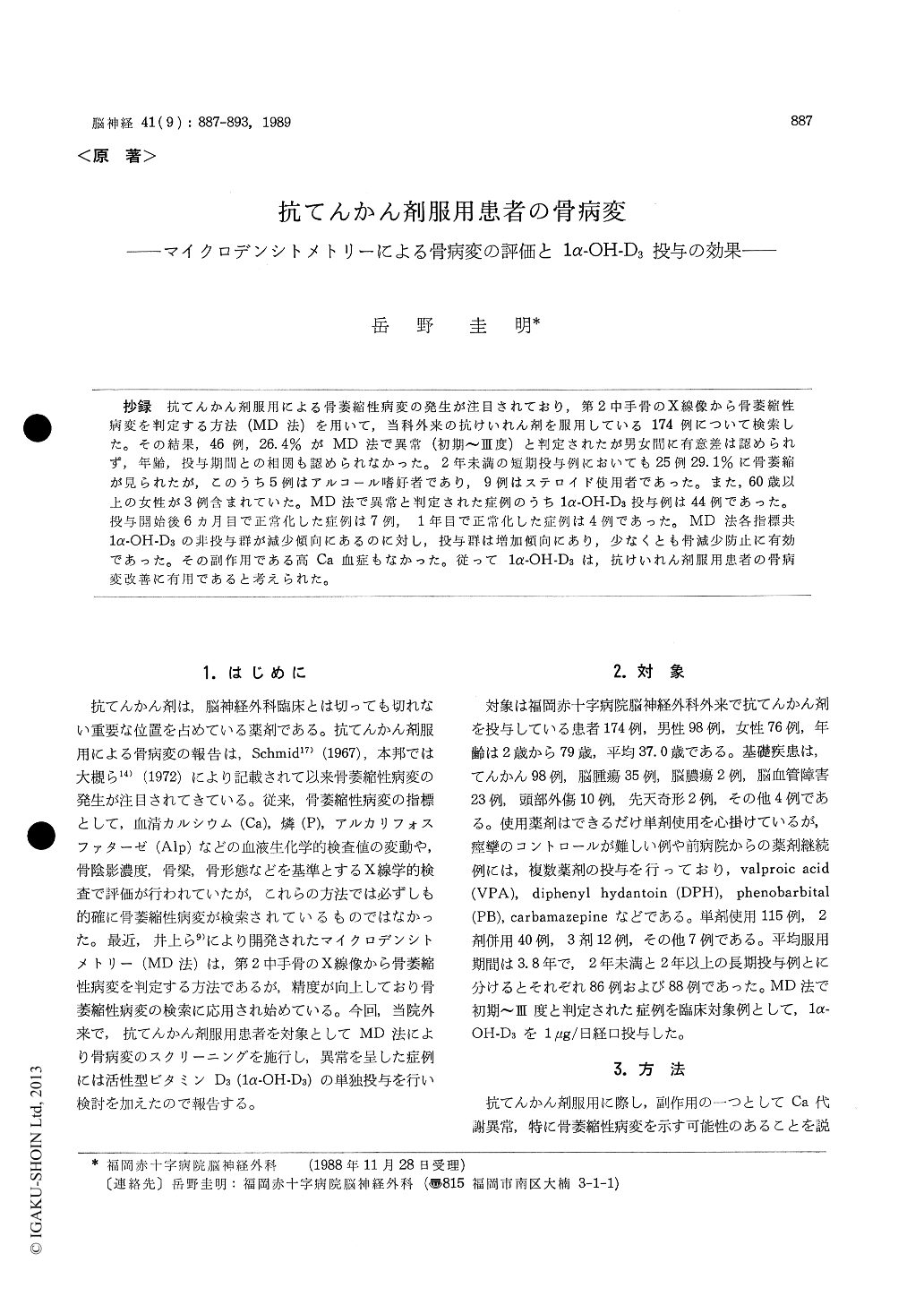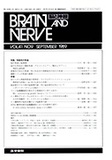Japanese
English
- 有料閲覧
- Abstract 文献概要
- 1ページ目 Look Inside
抄録 抗てんかん剤服用による骨萎縮性病変の発生が注目されており,第2中手骨のX線像から骨萎縮性病変を判定する方法(MD法)を用いて,当科外来の抗けいれん剤を服用している174例について検索した。その結果,46例,26.4%がMD法で異常(初期〜III度)と判定されたが男女間に有意差は認められず,年齢,投与期間との相関も認められなかった。2年未満の短期投与例においても25例29.1%に骨萎縮が見られたが,このうち5例はアルコール嗜好者であり,9例はステロイド使用者であった。また,60歳以上の女性が3例含まれていた。MD法で異常と判定された症例のうち1α—OH-D3投与例は44例であった。投与開始後6カ月目で正常化した症例は7例,1年目で正常化した症例は4例であった。MD法各指標共1α—OH-D3の非投与群が減少傾向にあるのに対し,投与群は増加傾向にあり,少なくとも骨減少防止に有効であった。その副作用である高Ca血症もなかった。従って1α—OH-D3は,抗けいれん剤服用患者の骨病変改善に有用であると考えられた。
Attention has been paid to bone atrophy caused by oral anticonvulsants.
Bone atrophy has been judged on X-ray picture in combination with measuring bio-chemical para-meters such as serum caclium (Ca), phosphorus (P) and alkaline phosphatase (Alp), and assessing X-ray findings such as bone density and morpho-logical findings of bone. However, the conventional techniques based on these parameters and findings do not always permit diagnosing the disease. Microdensitometric (MD) method, recently de-veloped by Inoue et al.39) as a method to assess the grades of severity of bone atrophy on X-ray picture of the metacarpal bone II, has been improved in its exactitude and widely applied in clinical practice for diagnosis of bone atrophy. In 174 patients receiving anticonvulsants, the severityof bone atrophy was quantitatively assesed by the MD method. 1 、μg/day of active vitamin D3 (1α-OH-D3) was administered to patients pre-senting abnormal MD findings indicative of bone atrophy, and the results were as follows :
1. Bone atrophy of grades initial to III was noted in 46 patients (26. 4%). There was no sex-difference in incidence of bone atrophy.
2. In patients receiving valproic acid (VPA) for two years or longer, there was no correlation between the duration of VPA treatment and the severity of the disease as assessed by MD method or its incidence, nor between the mean blood level of VPA and the severity.
3. Bone atrophy was found in 25 (29.1%) of the patients receiving anticonvulsants even for less then two years. Five of these 25 patients were alcoholists, and 9 patients received steroids. There were three women aged over 60 years.
4. Forty four patients (28 males and 21 females) were treated with 1α-OH-D3. MD parameters turn-ed to normal in 7 patients and 4 patients 6 months and one year after the initiation of treatment with the drug, respectively.
5. MD parameters all trended to decrease in la-OH-D3 non-treated group, while they increased in 1 a-OH-D3 treated group, indicating that the drug was effective, at least, to prevent the loss of bone mineral. Hypercalcemia, the most common side effect of the drug, was not found in any pa-tients.
In conclusion, 1 μg/day of 1 a-OH-D3 was assess-ed to be useful for improvement of bone disease in anticonvulsant-receiving patients.

Copyright © 1989, Igaku-Shoin Ltd. All rights reserved.


